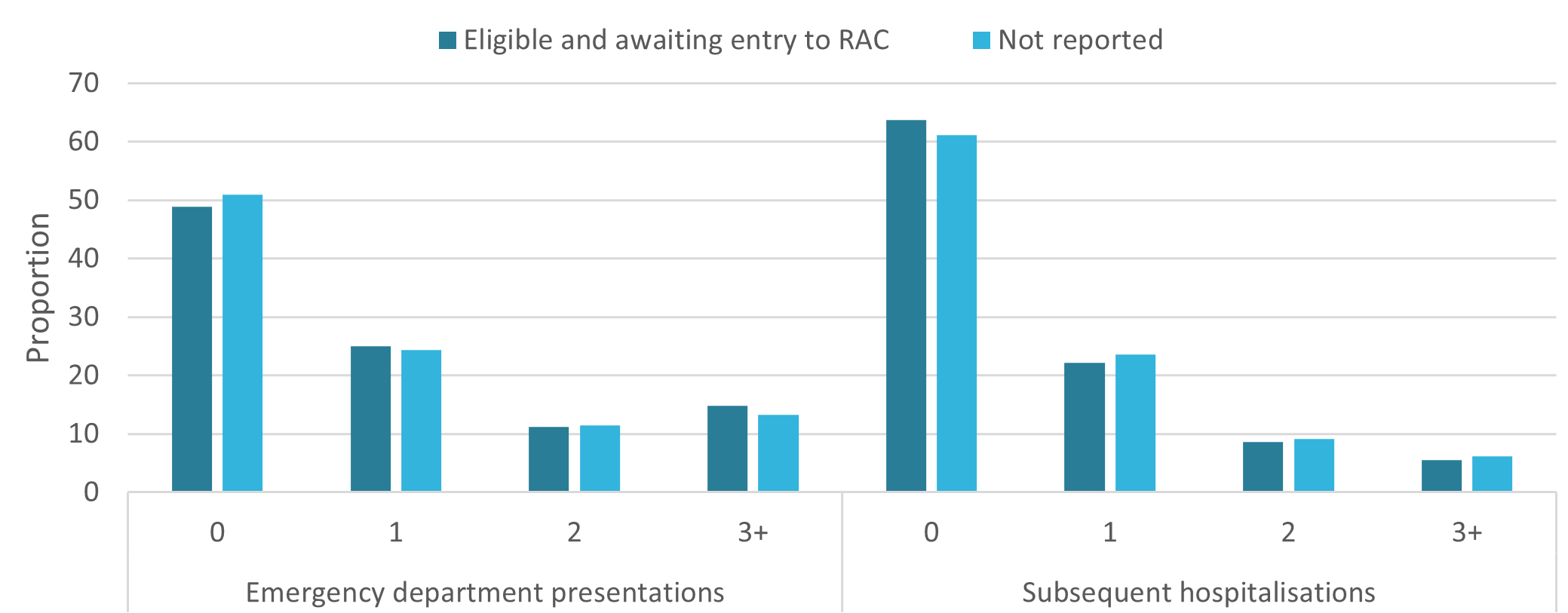People who were eligible and awaiting entry to residential aged care
This page shows the proportion of people who were reported to be eligible and awaiting entry to residential aged care during their first hospitalisation. It also shows the outcomes 12-months after discharge for people who were or were not reported to be eligible and awaiting entry to residential aged care, but these results are restricted to people who moved from living in the community to living in residential aged care within 7-days of discharge from their hospitalisation.
Outcomes for people who are eligible and awaiting entry to residential aged care are of interest because these people are at the interface between the hospital and aged care systems. Some people living with dementia may be turned away from residential aged care facilities if they have complex behaviours, and these people may stay in hospital longer than necessary.
People can receive an additional diagnosis during their hospitalisation that indicates they are ‘eligible and awaiting entry to residential aged care’ if they do not require further clinical care and are waiting in hospital until they can transfer to a residential aged care facility or because there are no appropriate residential aged care facilities in their district.
Eligible and awaiting entry to residential aged care
Less than 1% of people without dementia and 7% of people living with dementia were reported to be eligible and awaiting entry to residential aged care during their first hospitalisation. This varied by people’s change in usual residence or mortality after their hospitalisation (Table S1.20).
Over 1 in 3 people living with dementia (37%) and 1 in 4 people without dementia (27%) who moved from living in the community to living in residential aged care were most reported to be eligible and awaiting entry to residential aged care during their hospitalisation.
Around 9% of community-dwellers living with dementia and 2% of community-dwellers without dementia who died during their hospitalisation were flagged in their hospital record as being eligible and awaiting entry to residential aged care.
A small number of people who continued to live in the community (2%) were flagged as being eligible and awaiting placement in a residential aged care facility. It is not clear whether these people chose to return to live in the community despite being found eligible for a RAC placement, returned to live in the community while they waited to enter a RAC facility, or used a health or care facility not available in the linked data while they awaited entry to a RAC facility.
A small number of people who continued living in residential aged care (1%) were also reported to be eligible and awaiting entry to residential aged care, and it is likely that these people needed to or wanted to move to a different residential aged care facility after their hospitalisation.
Outcomes 12-months after discharge
Among people living with dementia who moved from living in the community to living in residential aged care within 7-days of discharge, outcomes 12-months after discharge were similar for people who were reported to be eligible and awaiting entry to residential aged care during their hospitalisation and people who were not.
- About 32% of people died within 12-months of discharge (including 13% who died within 3-months, Table S1.21)
Among people who survived for 12-months after discharge:
- About 50% of people had one or more emergency department presentations (Table S1.22)
- About 38% of people living with dementia had one or more subsequent hospitalisations (Table S1.23)
Figure 12 Number of emergency department presentations and subsequent hospitalisations for people living with dementia who were or were not reported to be eligible and awaiting entry to residential aged care

Note: this is limited to people who transitioned to live in residential aged care within 7-days of discharge from their first hospitalisation and survived for 12-months after discharge
Source: AIHW NIHSI 2018–19, analysis of NIHSI.


